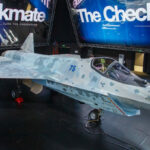A promising airborne defense complex is being created for attack helicopters of the Russian Air Force. The equipment will work on new principles and will allow to repel missiles with combined guidance systems. This was announced in an interview with RIA Novosti by Vladimir Artyakov, First Deputy Director General of Rostec State Corporation.
According to him, the evolution of airborne aircraft defense systems is a constant process, as the guidance systems of anti-aircraft and aviation missiles are constantly improving and their interference protection is growing.
“Under these conditions, work is certainly underway to create advanced airborne defense systems using both traditional and other principles of construction. They will make it possible to protect aircraft from guided weapons, including those with combined guidance systems,” Artyakov said.
He noted that the Vitebsk airborne defense system demonstrates high efficiency in the air defense zone, reliably protecting helicopters from MANPADS, including those of Western manufacture.
“According to pilots’ testimonies, thanks to this equipment it was possible to repel several launches of anti-aircraft missiles of various modifications at once and safely return to the airfield. In recent years, Vitebsk has undergone several stages of modernization, taking into account the recommendations of the military,” added Rostec’s first deputy general director.
In June 2023, an informed source told RIA Novosti that one of the Ka-52 attack helicopters at the expense of the Vitebsk complex repelled 18 missiles fired at it from man-portable air defense systems.
BKO “Vitebsk” includes ultraviolet sensors, means of active suppression, devices for shooting off false thermal targets and dipole reflectors. In automatic mode UV sensors detect anti-aircraft missile launches on the helicopter, and the control system calculates their coordinates. Then the most appropriate means of defense is put into operation. Interference stations are used to counter radar or active radar homing (ARH). Thermal optoelectronic systems or ARHs are suppressed by laser. Firing squibs with false thermal targets interferes with infrared homing heads of anti-aircraft missiles.







